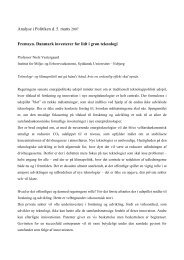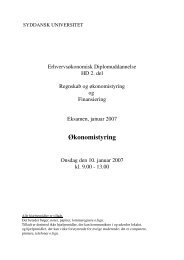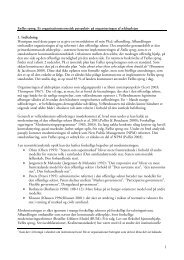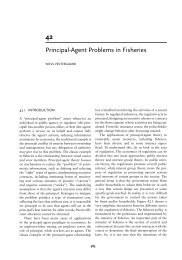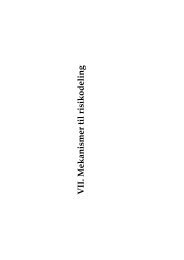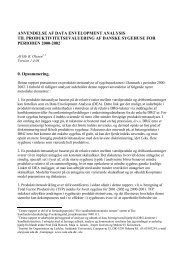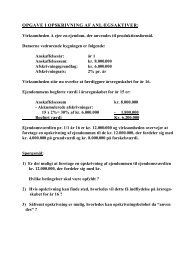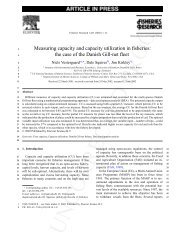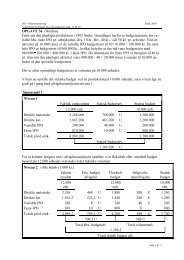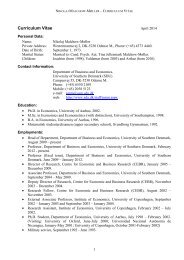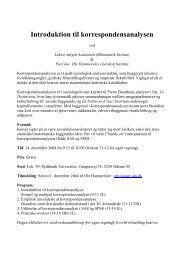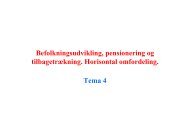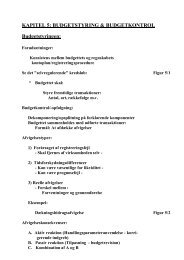Development of Parties and Party Systems in ... - lah@sam.sdu.dk
Development of Parties and Party Systems in ... - lah@sam.sdu.dk
Development of Parties and Party Systems in ... - lah@sam.sdu.dk
- No tags were found...
Create successful ePaper yourself
Turn your PDF publications into a flip-book with our unique Google optimized e-Paper software.
The economic recession <strong>and</strong> the grave social problems fundamentally changed Solidarity’s position.Under the then prevail<strong>in</strong>g extraord<strong>in</strong>ary politics it was difficult to formulate consistent attitudes tothe most press<strong>in</strong>g policy problems, also programmes for the future <strong>and</strong> l<strong>in</strong>ks to important social<strong>in</strong>terests <strong>in</strong> society were needed. The plans for the transition from plan to market were both vague<strong>and</strong> <strong>in</strong>consistent. Most important was to keep the communists out. As put by Voytek Zubek 44 ,Solidarity <strong>in</strong>directly supported the old communist view that the (new) system is basically ”healthy”<strong>and</strong> ”historically progressive” <strong>and</strong> ”the leaders (i.e. the Solidarity-leaders) always right”. Solidarityacted as it was enough to “conv<strong>in</strong>ce” the opponents <strong>and</strong> push the (post)communists <strong>in</strong> the defensive.From the outset Solidarity lacked well educated <strong>and</strong> pr<strong>of</strong>essional people especially on meso levelwho could fill out the vacuum left after the demise <strong>of</strong> the old nomenklatura, <strong>and</strong> thus create a new<strong>and</strong> better adm<strong>in</strong>istrative apparatus. Should Solidarity ga<strong>in</strong> governmental power, still the oldnomenklatura would have a considerable political <strong>in</strong>fluence because <strong>of</strong> the adm<strong>in</strong>istrative control.Also mechanisms for conflict solution <strong>in</strong> society were miss<strong>in</strong>g. Because <strong>of</strong> weak <strong>in</strong>terest groupsdissatisfaction was <strong>in</strong> many cases expressed on the streets, i.e. through protest strikes <strong>and</strong>demonstrations, sometimes <strong>in</strong> violent forms. The lack <strong>of</strong> political visions was politicallydemobilis<strong>in</strong>g, so evidence showed that under social <strong>and</strong> economic recession political programmes<strong>and</strong> visions for the future were strongly needed. On the way down <strong>in</strong> the “valley <strong>of</strong> tears” it wasalmost impossible to mobilise the voters politically <strong>and</strong> br<strong>in</strong>g them new hope <strong>and</strong> <strong>in</strong>spiration for thefuture.2.4. The new social environmentIn the new post-communist social environment tensions erupted between the old abstract goals forthe future <strong>and</strong> the day-to-day politics. Wnuk-Lip<strong>in</strong>ski rightly argues that the market orientedreforms <strong>in</strong>troduced after 1989 weakened the common <strong>in</strong>terests <strong>in</strong>side the social groups which untilthen had supported Solidarity, e.g. workers on big state enterprises, farmers <strong>and</strong> state-employed <strong>in</strong>the education <strong>and</strong> health sector. In the fight to take care <strong>of</strong> these groups’ dem<strong>and</strong>s <strong>and</strong> <strong>in</strong>terestsSolidarity had to compete with dem<strong>and</strong>s from other <strong>in</strong>terest groups <strong>and</strong> parties, e.g. OPZZ, SLD,PSL, KPN <strong>and</strong> UP. To accomplish that aim some <strong>in</strong> Solidarity wanted to speed up transition tomarket economy, almost at every cost. Other groups spoke about a specific ”third way” for Pol<strong>and</strong>based on catholic religious ethics <strong>and</strong> moral economics. After the found<strong>in</strong>g elections Solidarityfailed to formulate concrete programmes which could work as alternatives to Rakowski’s economicreforms.From the outset, the question whether Solidarity (”NSZZ Solidarnosc”) may constitute a politicalmovement or a trade union was difficult to answer. Compared with ”first Solidarity” after 1989 thesecond Solidarity became more ”exclusive”, <strong>and</strong> acted <strong>in</strong> a more restrictive way refus<strong>in</strong>g tocooperate with most other political parties <strong>and</strong> movements. The second Solidarity constituted abroad catch-all anti-communist movement. However, after 1989 more attention had to be paid to therealisation <strong>of</strong> concrete policy goals. Values <strong>and</strong> <strong>in</strong>terests had to converge, if the attempt to create afunctional party identity <strong>and</strong> culture should succeed. But on that po<strong>in</strong>t Solidarity faced bigproblems.As already said, the greatest support was obta<strong>in</strong>ed from conservatively m<strong>in</strong>ded workers on thebiggest state enterprises, i.e. the “d<strong>in</strong>osaurs” from the Stal<strong>in</strong>ist period. Support for Solidarity has44 Voytek Zubek, ”The Phoenix Out <strong>of</strong> the Ashes: The Rise To Power <strong>of</strong> Pol<strong>and</strong>’s Post-Communist SdRP”, Communist<strong>and</strong> Post-Communist Studies, Vol. 28, No. 3, 1995:275-306.52



